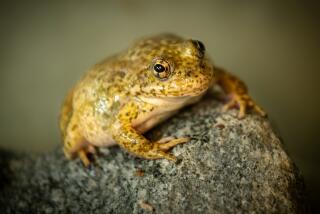Curious Case of Frogs Legging It for Parts Unknown
What’s the latest environmental crisis?
Frogs! Toads! Salamanders and other slime! They’re missing.
That, at least, is what the herpetologists say and as far as I’m concerned, anybody who would voluntarily call himself a herpetologist cannot be dismissed too lightly.
The Herps, you see, are getting together in three weeks at the National Academy of Sciences’ UC Irvine facility to ponder the mystery. They say they don’t know why the amphibians are going AWOL, just that they are.
This has got me to thinking hard about amphibians, trying to remember the last time I had a close encounter with one. There was that blind date in high school and a press conference by Newt Gingrich, but other than that, I’ve been drawing a blank.
Just as I was beginning to suspect that, gulp, it might really be Croak City, out of the blue came a lead.
A reader, a credible source in the past, wrote to complain about frogs flopping around in potholes over by the airport construction site. This reader wanted me on the case. He spoke of the county’s negligence and safety hazards and the possibility of a class-action lawsuit.
But by the time I checked it out--and believe me, given my heightened amphibian awareness it wasn’t long--the potholes had been paved over.
You guessed it. The frogs were missing.
By now I could see that this was getting serious. I decided to call a serious expert.
Turns out that Allan Shoenherr, a herpetologist at Fullerton College, has his own deep concerns about amphibians. Lately he hasn’t seen enough of the right amphibians, he says, as in our kind of amphibians, the natives.
He says the California red-legged frog, the foothill and mountain yellow-legged frogs, not to mention the estimable Western spadefoot toad, are but fond memories.
“The San Juan Creek used to flow to the ocean,” Shoenherr told me. “There were frogs all along there. . . . And then there were all those salamanders living in oak trees. Here in Orange County, when they go into places like Coto de Caza, what happens to the salamanders?”
I waited for the answer to that one, but there was silence on the line.
“Try driving up into Silverado or Modjeska canyon at night, in the rain,” Shoenherr said.
I thought this punishment was a tad harsh for missing just one question on the professor’s pop quiz, but before I could voice my objection, Shoenherr went on.
“There is a lot less human disturbance up there,” he said. “You should be able to see salamanders there. You might be able to see them on the roads. Now, do you think you would find that in Coto de Caza?”
OK, I thought I knew the answer this time.
“Coto de Caza is a gated community,” I said. “There’s no way they’re going to let me in to drive around at night in the rain.”
That about took care of the salamanders. But before the professor and I wrapped things up, he let me know about one more menace on the local amphibian scene--we’d already gone over the usual travesties associated with unbridled development--and frankly, I wasn’t quite ready for what I was about to hear.
The African clawed frog.
This is no joke, the prof says. Scientists imported the African clawed frogs to California in the 1940s to serve as amphibious pregnancy tests. If the frog ovulated after being injected with a woman’s urine it meant that the woman was pregnant.
But after the ovulating frog test fell out of favor--it turned out later that any frog would do--the Africans broke out of the lab and began colonizing the New World.
Now, of course, they’re everywhere.
A few years ago, water officials pulled a million of them out of the San Joaquin Reservoir above Newport Beach. And these frogs are true slime, rapacious and cannibalistic, with no natural enemies. They secrete poison through their skin.
“Nothing can stop them,” wrote Timothy Branning for the National Wildlife Federation in 1978 after the Department of Fish and Game’s first offensive against the beasts.
“They eat everything. Like a swarm of aquatic locusts, they can sweep through a pond leaving nothing behind. With their short, stubby forearms jerking spasmodically, they stuff food into their gaping mouths--fish, insects, eggs, tadpoles, frogs, anything within reach.”
So here’s my advice. Know your local amphibians. Spend some time with them, maybe share a meal.
But make sure you watch very closely. Not all frogs are good frogs. Once those table manners start to slip, you could be the one who’s missing next.
Dianne Klein’s column appears Wednesday, Friday and Sunday. Readers may reach Klein by writing to her at The Times Orange County Edition, 1375 Sunflower Ave., Costa Mesa, Calif. 92626, or calling (714) 966-7406.
More to Read
Sign up for Essential California
The most important California stories and recommendations in your inbox every morning.
You may occasionally receive promotional content from the Los Angeles Times.










